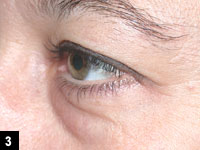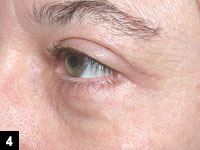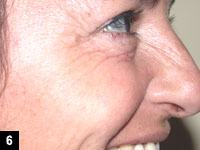Italian ophthalmologists increasingly involved in aesthetic procedures
collaboration among plastic surgeons, dermatologists and ophthalmologists is improving patient selection, lowering complication rates and widening treatment options.
![Claudio Lucchini, MD [photo]](/~/media/images/news/print/ocular-surgery-news-europe-asia-edition/2006/02_february/lucchini_70_90_6163.jpg) Claudio Lucchini |
Italian ophthalmologists are becoming increasingly involved in aesthetic surgery, a field they had neglected for many years, according to one ophthalmologist.
“Oculoplastics is a logical evolution of our expertise and a rightful broadening of our market. If for many years we have limited ourselves to reconstructive surgery, we are now extending our interest and active involvement in all aspects of aesthetic periorbital surgery and facial plastic surgery,” said Claudio Lucchini, MD, an early adopter of this new trend in Italy.
He noted that more ophthalmologists are starting to participate in plastic surgery meetings and courses.
“Although we are still a minority, we are establishing ourselves as a new, enthusiastic and energetic subspecialty group. Contrary to what happens in other areas of ophthalmology, oculoplastics is at present a field of fast and dramatic development, and it’s a great privilege to be participating during this very exciting time,” he said.
Choosing an ophthalmologist
Ophthalmic surgeons are in the privileged position of having many potential oculoplastic candidates among their existing patients, Dr. Lucchini said.
“Of course they need to know that we are offering this type of treatment, which the public doesn’t normally associate with our specialty, or at least until now,” Dr. Lucchini said.
He said he has found that most of his patients welcome the opportunity to be treated by the same specialist who takes care of their eyes because they know and trust him and in many cases have experienced his skills as a surgeon. They also think that an ophthalmologist has specific knowledge in areas surrounding the eye and that they will pay more attention when working in this area.
“A belief that is not far from the truth because we do know better than any other specialist the anatomy, the physiology and the pathology of the eye in all its many aspects. Moreover, we are used to operating with microscopic precision and accuracy,” Dr. Lucchini said.
Multidisciplinary approach
On a professional and scientific level, the specific skills that ophthalmologists can offer have contributed to the recent advances of periorbital surgery.
Dr. Lucchini said he is proud that the new trend he has helped to establish in Italy is based on close cooperation between the three specialties that deal with periorbital surgery and facial plastic surgery.
“Through the organization of national annual meetings of ophthalmologists, plastic surgeons and dermatologists, we are developing a true multidisciplinary approach to facial plastic surgery, and in 6 years we have already seen the extraordinary results of this synergetic cooperation,” he said. “We have all grown professionally because we have been able to benefit from each other’s experience. Our patient selection has improved, and we have developed new techniques that produce better results and fewer complications.”
From plastic surgeons, ophthalmologists have learned surgical procedures they were not normally using, and from dermatologists they have learned about the use of dermal fillers and laser skin resurfacing. Likewise, plastic surgeons and dermatologists have developed a more respectful attitude toward the eye and have become more aware of the effects of their treatments on the eye anatomy and visual function, Dr. Lucchini said.
|
|
|
|
|
Images: Lucchini C |
Increasing demand
In terms of numbers, ophthalmologists now equal plastic surgeons in the acquisition of oculoplastic patients, according to Dr. Lucchini.
“Following a trend that has now reached Italy, the demand for aesthetic treatment is constantly growing. Blepharoplasty is still the main domain of ophthalmologists, but an increasing number of my colleagues are now learning and offering a wide range of other treatments, with a positive response from their patients,” he said.
He noted that the age of patients who seek aesthetic treatments has become lower in recent years. The age range for blepharoplasty is between 30 and 70 years, which is 15 years less than it used to be. With botulinum toxin, soft laser treatment and dermal fillers, the demand starts at an even earlier age, he said.
More men, especially ones in their 40s and 50s, are having procedures now. The male:female ratio is approximately 1:4, Dr. Lucchini said.
Social stratification is also changing. Most patients who ask for Botox (botulinum toxin type A, Allergan) and fillers come from lower middle-class incomes and save money for periodic treatments, he said.
“What they are beginning to realize is that the money they used to spend on anti-wrinkle creams and lotions is about the same as what they require for one or even two treatments a year with incomparably better results,” Dr. Lucchini said.
In Italy, the cost of each treatment is set by individual specialists. The separate cost of both upper- and lower-lid blepharoplasty ranges between US$1,900 and US$2,600 for both eyes. Laser resurfacing costs an additional US$1,300.
CO2 laser resurfacing costs between US$1,300 and US$1,900; a single dose of hyaluronic acid filler is between US$250 and US$380; and a botulinum toxin treatment in three areas costs approximately US$380.
For Your Information:
- Claudio Lucchini, MD, can be reached at Via Leopardi 2, 20133 Milan, Italy; phone/fax 39-024-398-1956; e-mail: ludoc@fastwebnet.it.
- Michela Cimberle is an OSN Correspondent based in Treviso, Italy.






